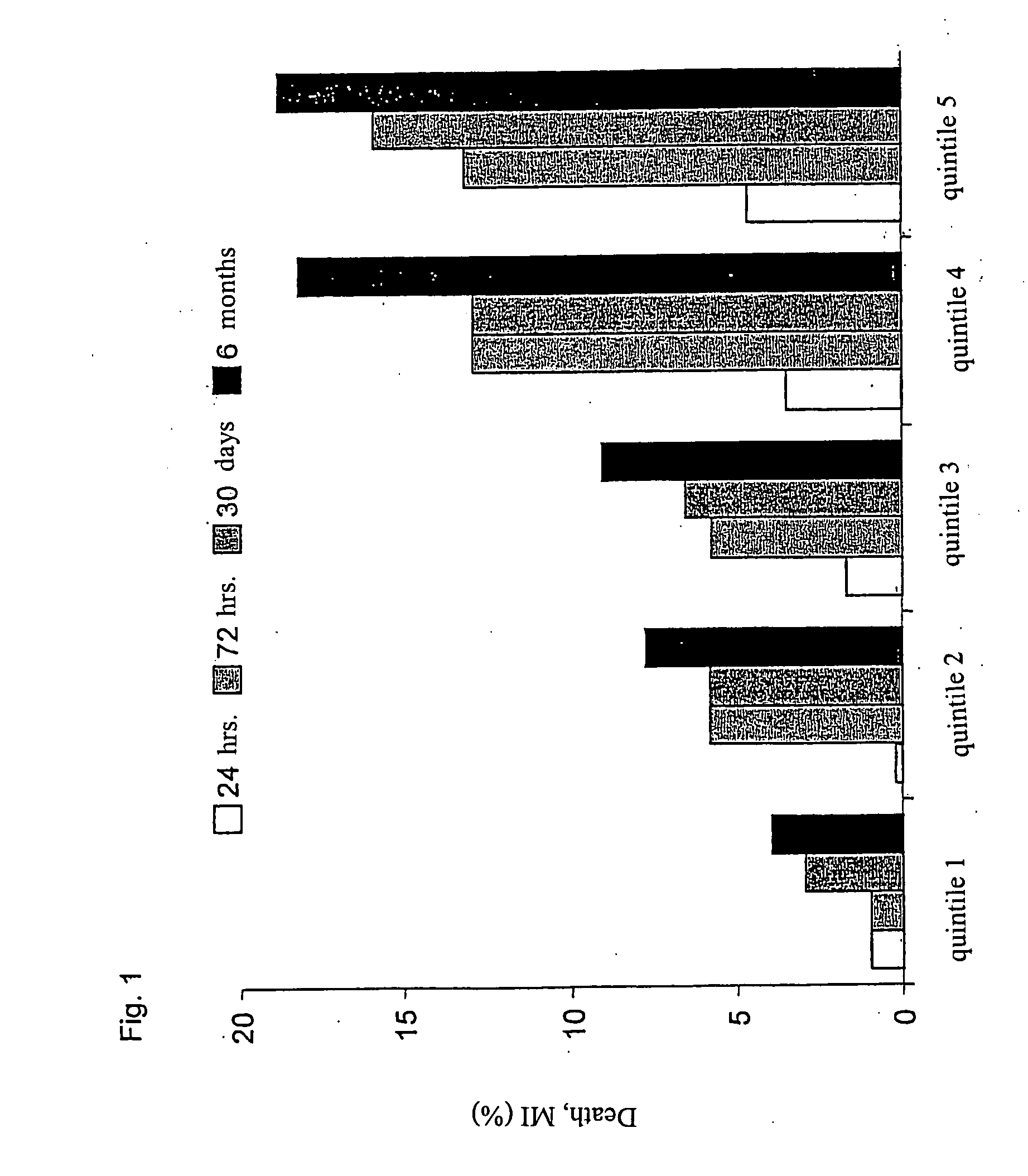Scd4ol and placental growth factor (plgf) used as a biochemical marker combination in cardiovascular diseases
a biochemical marker and placental growth factor technology, applied in the direction of ngf/tnf-superfamily, antibody ingredients, peptide sources, etc., can solve the problems of unsatisfactory exclusion of acute myocardial infarction in accordance with actual standards, and the inability to identify reliable biochemical markers for platelet activation,
- Summary
- Abstract
- Description
- Claims
- Application Information
AI Technical Summary
Problems solved by technology
Method used
Image
Examples
example 1a
Association Between Cardiac Risk and sCD40L-Concentration
[0106] The characteristics of the outcome for the population that was selected for this study (n=1088, 86% of the CAPTURE-patients) did not differ from the total population of the study regarding age, gender, cardiovascular risk profile, and accompanying treatment before and after the random selection. The reduction of cardiac events in the abciximab-group of the population was comparable with the overall CAPTURE-population (before PTCA: 2.2% placebo vs. 0.9% abciximab, p=0.094; after PTCA: 7.9% vs. 3.5%, p=0.002; after 30 days: 9.0% vs. 4.2%, p=0.002) (CAPTURE. Lancet 1997; 349: 1429-35).
[0107] sCD40L could be detected in the base line-serum samples of all 1088 patients with an average of 4.5 μg / l (range 0.003-20.4). The sCD40L-concentration did not correlate with the measured concentrations of TnT (r=0.14) and CRP (r=0.11). The patients of the placebo-group (n=544) were grouped into quintiles in accordance with their sCD40...
example 2a
Angiographic Results and sCD40L-Concentration
[0110] The base line coronary angiograms in patients with elevated sCD40L-concentrations showed more complex characteristics of the lesions. Lesions of type B2+ or C were documented in 40.6% of the patients with high sCD40L-concentrations, whereas only 27.5% of the patients with low sCD40L-concentrations exhibited more complex characteristics of the lesions (p=0.004).
[0111] In 59.6% of the patients with high sCD40L-concentrations and in 58.9% of the patients with low sCD40L-concentrations the base line value for the TIMI-flow-through was normal (p=0.049). For 7.8% of the patients with high sCD40L-concentrations a TIMI-flow-through=1 was documented compared to 5.7% of the patients with low sCD40L-concentrations (p=0.67).
[0112] A thrombus at the time of presentation was visible in 11.1% of the patients with high sCD40L-concentrations compared to 4.8% patients with low sCD40L-concentrations (p=0.009). All patients with visible thrombus fo...
example 3a
Effect of Abciximab on the sCD40L-Concentration
[0113] A logistic regression analysis pointed towards a significant association between the effectiveness of a treatment with abciximab and the sCD40L-concentrations (pa). In patients with low sCD40L-concentrations no difference was observed between patients that received abciximab and those that received placebo (24 hours: 1.2% vs. 0.9%; 72 hours: 3.8% vs. 4.3%). In the following 6 months, only very few additional events were registered. The overall frequency was 7.1% (FIG. 4b).
[0114] In contrast to this, the frequency of attacks was significantly higher in patients with high sCD40L-concentrations receiving placebo, both before PTCA (4.1%) as well as under PTCA (9.0%) as well as in the following time after discharge, leading to an overall frequency of 18.6% after six months. Events that occurred before and under PTCA were effectively reduced to 0.5% before PTCA (risk quotient 0.12 [0.01-0.92]; p=0.013), and 2.9% for PTCA-related even...
PUM
| Property | Measurement | Unit |
|---|---|---|
| Fraction | aaaaa | aaaaa |
| Fraction | aaaaa | aaaaa |
| Fraction | aaaaa | aaaaa |
Abstract
Description
Claims
Application Information
 Login to View More
Login to View More - R&D
- Intellectual Property
- Life Sciences
- Materials
- Tech Scout
- Unparalleled Data Quality
- Higher Quality Content
- 60% Fewer Hallucinations
Browse by: Latest US Patents, China's latest patents, Technical Efficacy Thesaurus, Application Domain, Technology Topic, Popular Technical Reports.
© 2025 PatSnap. All rights reserved.Legal|Privacy policy|Modern Slavery Act Transparency Statement|Sitemap|About US| Contact US: help@patsnap.com



